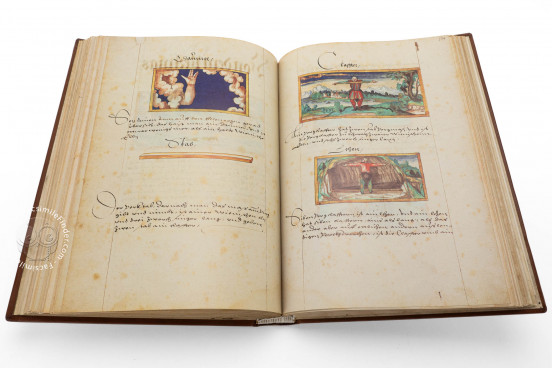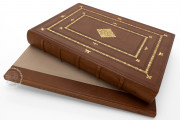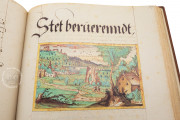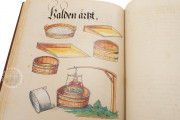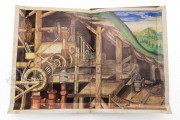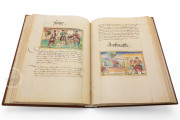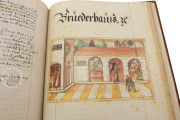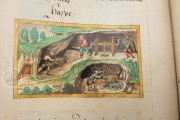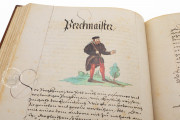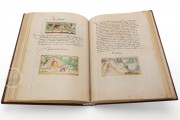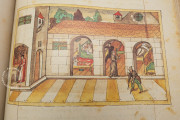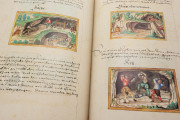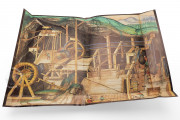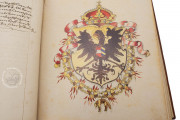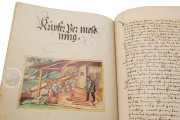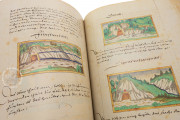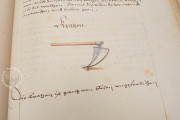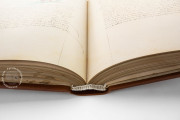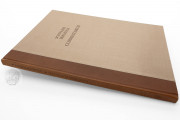The Mining Book of Schwaz was produced in 1561. Local mining authorities commissioned the text to document and promote the mining industry in Tyrol, which was rich in silver and copper. It describes and illustrates the geography of Tyrol and its mines. The manuscript's 121 miniatures, which include twenty-three double-page fold-out images, include striking cutaway scenes that show mining machinery in operation. Both technical and administrative officials are shown, as are local villages, emphasizing the importance of mining for people throughout the region.
Beyond its artistic merit, the manuscript serves as an exceptional documentary source for mining operations in Schwaz, Tyrol, establishing it as a priceless jewel within European scientific literature.
Rich and Informative Illustrations
The manuscript brilliantly captures daily work routines and social interactions, providing a comprehensive perspective on the legal, economic, social, and cultural dimensions of 16th-century mining. Notably, the Mining Book of Schwaz reflects upon the legendary mines of Schwaz during the conclusion of their prosperous era. Rather than being printed for widespread circulation, this carefully handwritten and illustrated work was created exclusively for a limited, elite readership.
Schwaz: "Mother of All Mines"
The town of Schwaz gained prominence in the 15th century for its abundant silver and copper deposits. Its dominant position in the mining industry earned it the distinguished title "mother of all mines." When Emperor Maximilian I ascended to the throne, Schwaz became the financial foundation supporting his ambitious imperial projects. The influx of miners rapidly transformed this Tyrolean village into Austria's second most populous community, surpassed only by Vienna.
The Mining Book of Schwaz was commissioned when the mining industry, after a century of European metallurgical leadership, had already begun to decline and face significant challenges. Authored by a high-ranking official from the regional mining authority, the manuscript likely served three primary purposes: first, to acquaint Emperor Ferdinand I with his most valuable resource and emphasize mining's importance to his economic and political interests; second, to attract new investors to purchase shares; and third, to provide a thorough overview of legal and safety aspects of mining in preparation for the 1557 mining conference.
An Invaluable Source for Mining History
The manuscript is methodically organized into four distinct sections. The first addresses mining regulations, which were more stringent than modern standards, covering property rights, mining inspectorates, operational organization, environmental protections, labor and social laws, and specialized mining jurisdiction.
The second comprehensive section contains memorials on mining practices, recommendations to the sovereign, task-specific instructions, and detailed descriptions of mining operations in Schwaz. It further outlines the responsibilities of mining officials and the duties and compensation of miners.
The third section presents an illustrated mining encyclopedia—the oldest of its kind—featuring colorful depictions of ongoing work processes and equipment, accompanied by practical, application-oriented descriptions.
The fourth section compiles the jurisdictional practices of the Schwaz mining court, including significant judgments, procedural directives, and protocols for miners' court appearances.
The Artistic and Historical Significance of the Miniatures
Beyond the detailed exposition of Mining Law and remarkable features illustrating the Schwaz deposits' exploitation, the accompanying text offers extraordinary contextual value. The finely colored pen and ink drawings vividly portray various mining activities, providing authentic representations of period machinery, miners' attire, and the formal robes worn by high officials at court.
The foldout illustrations depicting mining areas are particularly significant for topographical studies, as they represent some of the earliest visual records of villages and mountain landscapes ever created. While Agricola's famous mining textbook (De re metallica libri XII, printed in 1556) primarily describes contemporary mining technology, the Mining Book of Schwaz distinguishes itself through its comprehensive illustration of mining in all its dimensions and its vibrant, colorful visual narrative.
We have 1 facsimile edition of the manuscript "Mining Book of Schwaz": Schwazer Bergbuch facsimile edition, published by Akademische Druck- u. Verlagsanstalt (ADEVA), 1988
Request Info / Price
